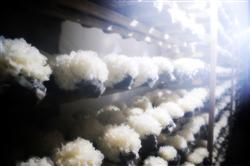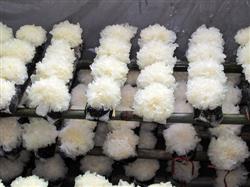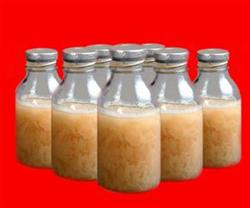How to cultivate Tremella fuciformis?

How to cultivate Tremella? How many cultivation methods are there? Tremella fuciformis is a kind of advanced tonic, with strong essence, kidney, lungs, salivation and other functions, and can promote human metabolism, skin tenderization, body-building role. Growth conditions Tremella growth needs a certain temperature, humidity, light, air, pH, nutrition and other six conditions. 1. Temperature: Tremella fuciformis is a mesophilic fungus. Hyphae can grow at 6~32℃, the most suitable temperature is 22~25℃, fruiting body growth is 15~30℃, but the most suitable temperature is 22~27℃, spore germination is 15~32℃, and the most suitable temperature is 22~25℃. 2, humidity: Tremella growth and development needs water, but in different growth stages, different water is needed, in the vegetative growth stage, the base water content is 55~65%, in the reproductive growth stage, the air relative humidity is required 85~95%, lower or higher than this range is not conducive to Tremella growth. 3. Light: Although Tremella growth cannot carry out photosynthesis, low light can promote the formation of fruiting bodies, complete darkness and strong direct light are unfavorable to Tremella differentiation and growth, and it is most suitable for indoor scattered light. 4, air: Tremella is an aerobic fungus, especially in the fruiting body growth stage, continuous breathing, exhaust carbon dioxide, breathing fresh oxygen, in the oxygen deficiency conditions, fruiting body primordium is not easy to develop into pieces, growth weakness, easy to infect miscellaneous bacteria, resulting in rotten ears. 5. pH value: The spore germination and mycelium growth of Tremella fuciformis are suitable for pH 5.0 ~6.5, and pH value below 4.5 or above 7.2 is not suitable for spore germination and mycelium growth. 6, nutrition: Tremella is a sapropel bacteria, can only decompose and digest ready-made organic matter, mainly absorb carbon nutrition, followed by nitrogen nutrition and inorganic salt nutrition, Tremella mainly uses lignin and cellulose, so in Tremella substitute cultivation, can not use a raw material alone, using a combination of raw materials to use better results. Cultivation techniques: 1, bottle or bag planting bottle or bag planting raw material preparation: A, saw wood 75%, wheat bran 20%, soybean flour 1.5%, white sugar 1%, gypsum 2%, magnesium sulfate 0.25%, potassium dihydrogen phosphate 0.25%, water 1.2:1, PH natural. B, cottonseed hull 70%, wheat bran 25%, white sugar 1%, gypsum 2%, soybean flour 1.5%, magnesium sulfate 0.5%, water 1.3:1, PH natural. C, straw powder 50%, wheat straw powder 20%, wheat bran 20%, calcium superphosphate 5%, white sugar 1%, gypsum 2%, soybean powder 2%, water 1.2:1, PH natural. Mix the raw materials thoroughly and put them into open bottles or plastic bags. The bottle surface should be slightly flattened and the contaminated culture materials inside and outside the bottle wall should be cleaned. After the plastic bag is filled, the two ends are tightly sealed with thread, and then the bag is slightly flattened with a wooden board. 3~4 holes are drilled on the top with a tool with a diameter of 8.5, and the depth is 1.5 cm. The medicinal adhesive tape is pasted on the hole for high temperature sterilization. Sterilization method: The earthen seeds are generally steamed from boiling water for 6~8 hours. Autoclave sterilization at 1.5 kg/cm, that is, 127℃ for 1 hour can be cooled after inoculation. Inoculation room or inoculation box shall be disinfected with formalin and potassium permanganate mixture. 6~ 10ml formalin and 5~ 10g potassium permanganate shall be used for each cubic meter space. Inoculation shall be started after disinfection for half an hour. Inoculation method: First scrape off a layer of 1 cm thick on the surface of the original seed, then stir the seed evenly, put it into the bottle or plastic bag cave, 80 bottles or 40 bags can be connected to each bottle of original seed, after inoculation, culture at 22~28℃, observe the contamination of miscellaneous bacteria at any time during the culture process, and deal with it in time if found, so as to prevent infection. A month or so will appear small ear buds, 28 days or so should be attached to the adhesive tape tear, promote the early formation of fruit bodies, ears after maintaining a certain temperature and ventilation, about 7 days can be harvested a batch. 2, wood cultivation in places where there are resources, can use wood cultivation method is simpler, effective quickly. Tremella suitable for cultivation of a wide range of trees, green bar trees, alder trees, eucalyptus, willow, elm, locust tree, Chinese parasol trees, plum trees, apricot trees, pear trees, peach trees, mulberry trees, maple trees and other trees can be cultivated, the size of the tree is generally 5~15cm in diameter is appropriate, cultivation time according to the combination of natural temperature, the most suitable between March and April, should be cut 1~2 months in advance, let xylem water naturally lose 20~30% when inoculation. Section inoculation method: the ear stick with a pecking axe or drilling machine hole, every 3 inches hit a hole, depth of 2 cm, big stick hit 5~6 rows, small stick hit 2~4 rows, can not be too thin too dense, after the hole hit, the seed block each eye plug a piece, knock in with a hammer, must be tightly plugged to prevent falling off, it is best to use the side drilling, inoculation, side stacking sweating, so as to avoid dry strains and miscellaneous bacteria pollution. After inoculation, the ear rods are stacked in time to sweat, and the ear rods are stacked into a "well" shape, about 4 feet high, surrounded by plastic film, and covered with green branches or grass lotus, so as to keep warm and ventilate, which is beneficial to the development of tremella hyphae. in that sweat stage, the rod must be turned ov once every 10 days or so, and the upper and lower parts and the inside and the outside are mutually adjusted. according to the dry condition of the ear rod, water can be sprinkled appropriately, and after turning over, the covering material is covered well. after about one month of sweat management, small tremella will appear one after another. at this time, humidity and wind ventilation should be increased to make tremella grow healthily. if 30% tremella appears, the rod should be removed from the pile. it is appropriate to require each ear rod to be separated by 5 inches indoors or outdoors. in order to save cultivation space, Can also use space area, multi-layer shelf cultivation method, both moisture, in order to facilitate centralized management, tremella growth process, mainly afraid of wind, indoor water consumption is small, watering once a day, according to moisture increase or decrease, outdoor sprinkling 2~3 times a day, in short, maintain the relative humidity of the air 85~95% is appropriate. Harvest: Tremella mature, should be timely harvest, otherwise it will rot, harvest standard is generally large and small, ears fully developed, soft harvest. Harvesting method: Cut off the root of Tremella with a knife, leaving ears and feet for it to germinate again. Bag planting Tremella generally harvest 3~4 batches, cycle about 3 months, each hundred catties of raw material right yield dry Tremella 10~20 jin, Duan wood cultivation can receive 3~4 batches in the first year, the second year can also receive 2~3 batches, each hundred catties Duan wood can receive 5~10 jin Tremella. Tremella harvest, should be timely drying or drying, in the sun generally takes 2 to 3 days to dry, with carbon fire drying should be mastered at 60℃ about half a day to dry, dry moisture preservation. Click for more Tremella cultivation techniques Click for more edible mushroom cultivation techniques
- Prev

What are the requirements for the growing environment of Tremella fuciformis?
What are the requirements for the growing environment of Tremella fuciformis? Tremella fuciformis can not do photosynthesis like plants, use chlorophyll to make its own nutrients, but rely on organic matter in other organisms as its nourishment, absorb ready-made carbohydrates, nitrogenous substances and small amounts of minerals. All kinds of substitute materials.
- Next

How to make the strain of Tremella fuciformis?
How to make the strain of Tremella fuciformis? Please introduce the method of planting Tremella fuciformis with a wide range of raw materials and easy to obtain, so it has a bright future. A peasant family, as long as the use of 15 square meters of 2 houses, one can plant 2500 bags, a year can grow 6 batches, a net profit of more than 8000 yuan. Every 100 kg of cottonseed hulls or sawdust can be collected.
Related
- Fuxing push coffee new agricultural production and marketing class: lack of small-scale processing plants
- Jujube rice field leisure farm deep ploughing Yilan for five years to create a space for organic food and play
- Nongyu Farm-A trial of organic papaya for brave women with advanced technology
- Four points for attention in the prevention and control of diseases and insect pests of edible fungi
- How to add nutrient solution to Edible Fungi
- Is there any good way to control edible fungus mites?
- Open Inoculation Technology of Edible Fungi
- Is there any clever way to use fertilizer for edible fungus in winter?
- What agents are used to kill the pathogens of edible fungi in the mushroom shed?
- Rapid drying of Edible Fungi

